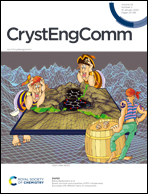Insight into the role of hydrochloric acid in the thermodynamics and nucleation kinetics behavior of Arbidol hydrochloride monohydrate from metastable zone widths†
Abstract
In order to investigate the nucleation behavior of Arbidol hydrochloride monohydrate (AHM) in aqueous THF (tetrahydrofuran) solutions, the metastable zone width (MSZW) was experimentally determined via the polythermal method, and then the modified Sangwal's theory was employed to explain the nucleation process. Via the MSZW investigation, the presence of hydrochloric acid might contribute to the nucleation process of AHM from the crystallization mother liquor, which accords with our previous experimental result that it is vital to manufacture AHM in a solvent system with hydrochloric acid. Based on classic nucleation theory, the modified Sangwal's theory was also employed to separately estimate the solid–liquid interfacial tension, critical nucleus size and the nucleation Gibbs energy. Moreover, it is also proved that the solid–liquid interfacial tension relies not only on temperature, but also on the nucleation driving force. The surface roughness factor fr was estimated to imply the occurrence of continuous growth at the crystal interface of AHM in aqueous THF solutions. Finally, comparisons of the calculated and experimental induction times indicate that Kubota's theory has a high applicability for AHM in an aqueous THF system.



 Please wait while we load your content...
Please wait while we load your content...